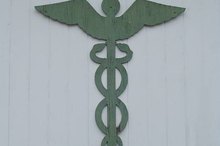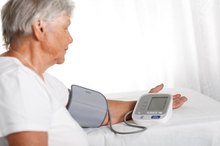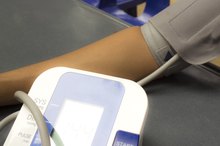How to Calibrate a Blood Pressure Monitor
Checking your blood pressure regularly is an important component in an overall program to reduce your risk of heart disease and stroke. Since you can have high blood pressure without any symptoms, checking your pressure is often the only way to know if it is high. There are many different types of monitors on the market that can be used at home. Your health care provider may be able to recommend a model that would be best. Once you have your monitor, you will periodically need to calibrate it to make sure you are getting the most accurate reading. According to the Food and Drug Administration (FDA), calibrating your blood pressure monitor ensures that the blood pressure measurement begins at zero. This works the same as the scale you weigh yourself on. If the scale is not balanced at zero, your body weight measurement will be inaccurate. With a blood pressure monitor, if the device's starting point is above or below zero, the final reading will be inaccurate. The FDA warns that many electronic devices may not be regularly calibrated, leaving consumers with erroneous readings. See the link in Resources for the FDA.
If you are experiencing serious medical symptoms, seek emergency treatment immediately.
Take your monitor to your physician. This is the easiest way to check the accuracy of your blood pressure monitor. Your physician or nurse should watch you take your blood pressure with your monitor to make sure you are doing so correctly. Then, have your doctor take your pressure with her equipment and make note of any variations. This will not actually calibrate your device, but you will know how accurate your monitor really is. The American Heart Association recommends that you repeat this test once per year.
How to Troubleshoot a Blood Pressure Monitor
Learn More
Purchase a good monitor and make sure it is reliable. The American Heart Association recommends purchasing a monitor that has been validated through the Association for the Advancement of Medical Instrumentation, British Hypertension Society or the International Protocol for the Validation of Automated BP Measuring Devices. This, along with a program of regular maintenance, should help cut down on inaccurate readings. You will be purchasing a machine that is already correctly calibrated and comes with instructions on how to maintain and calibrate your monitor. Since each monitor is different, follow the manufacturer's instructions that came with your monitor. In some cases, you may need to inflate and deflate the cuff a few times as you adjust a screw or knob until the device is calibrated. Even if there are instructions for self-calibrating your monitor, you should still check it against the one at your doctor's office.
Send your monitor to a specialized company or check with the manufacturer of your blood pressure monitor. The manufacturer may have a factory where your device can be calibrated for you. There are also organizations that specialize in calibrating blood pressure monitors. This is usually reserved for monitors that are used in medical settings, as it is quite expensive.
Tips
Understand your readings. The Joint National Committee on Prevention, Detection, Evaluation, and Treatment of High Blood Pressure states that Normal blood pressure is systolic pressure less than 120 and diastolic pressure less than 80 mmHg. Prehypertension is diagnosed when your systolic pressure is between 120 to139 mmHg or your diastolic pressure is between 80 to 89 mmHg. Stage 1 Hypertension occurs when your systolic pressure is between 140 to159 mmHg or your diastolic pressure is between 90 to 99 mmHg. Stage 2 Hypertension occurs when your systolic pressure is 160 mmHg or greater or your diastolic pressure is 100 mmHg or greater.
Warnings
Never use your home monitor or a monitor in a store as the only source to check your blood pressure levels. Your doctor can make sure your levels are healthy, and she can also listen to the sounds in the heart, lungs and blood vessels to pick up on any potential problems.
Related Articles
Tips
- Understand your readings. The Joint National Committee on Prevention, Detection, Evaluation, and Treatment of High Blood Pressure states that Normal blood pressure is systolic pressure less than 120 and diastolic pressure less than 80 mmHg. Prehypertension is diagnosed when your systolic pressure is between 120 to139 mmHg or your diastolic pressure is between 80 to 89 mmHg. Stage 1 Hypertension occurs when your systolic pressure is between 140 to159 mmHg or your diastolic pressure is between 90 to 99 mmHg. Stage 2 Hypertension occurs when your systolic pressure is 160 mmHg or greater or your diastolic pressure is 100 mmHg or greater.
Warnings
- Never use your home monitor or a monitor in a store as the only source to check your blood pressure levels. Your doctor can make sure your levels are healthy, and she can also listen to the sounds in the heart, lungs and blood vessels to pick up on any potential problems.
Writer Bio
I hold a Master's degree in exercise physiology/health promotion. I am a certified fitness specialist through the American College of Spots Medicine and an IYT certified yoga teacher. I have over 25 years experience teaching classes to both general public and those with chronic illness. The above allows me to write directly to the reader based on personal experiences.







